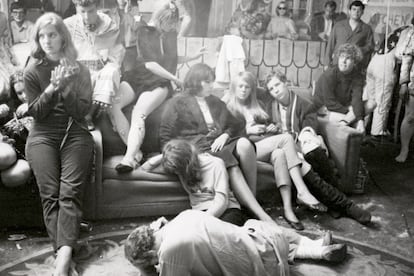Psychedelics: an amazing world that reveals philosophical phenomena
Treatments have confirmed the therapeutic efficacy of psychoactive substances such as LSD and THC… but the debate about their relationship with consciousness has only just begun

The philosophical debate surrounding psychedelics has only just begun.
In the 1950s, research using psychoactive substances experienced a golden age. But the Vietnam War (1955-75) – along with certain unfortunate events that took place in the counterculture of the 1960s – resulted in the subject becoming taboo.
In response to the controversy, the Nixon administration (1969-74) stopped funding this particular line of research and ultimately prohibited it. It wasn’t until the beginning of the 21st century that the controlled use of psychoactive substances was restarted, specifically in therapies associated with terminal illnesses, anxiety disorders, depression, psychosocial distress, addiction and post-traumatic stress.
Treatments have since confirmed the therapeutic efficacy and transformative effects of these substances. Even in healthy volunteers, significant and prolonged psychological benefits have been found. Some of the patients report diverse experiences, such as dissolution of the ego, or overcoming the limitations of space and time. They feel that time slows down, or even stops… they have the impression of belonging to a cosmic consciousness, feeling at one with the universe.
Other participants go further, speaking of genuine intuition: the divine is not “out there” somewhere, but within oneself. To put it in terms of Alan Watts – the American philosopher who popularized Eastern philosophies for Western audiences – truth is not something that is known, but something that, simply, is. It is love; it is all things. A type of experience close to some of the states of Buddhist meditation, which calls into question the materialistic worldview, according to which consciousness is not the foundation of the cosmos, but a late, expendable and occasional guest at the party of evolution.
From the physicalist or modern perspective, the mystical claims of psychedelic subjects would be nothing more than metaphysical and illusory hallucinations of aberrant brain activity. Be that as it may, psychedelic science reveals phenomena of deep philosophical interest. Aldous Huxley saw in psychedelic revelations the “antipodes of the mind” – a promising region for rigorous scientific research. For psychiatrist Stanislav Grof, the new substances were like astronomers’ telescopes and biologists’ microscopes: powerful tools for mapping the mind. According to Grof, the mind cannot be understood by breaking it down. Rather, it requires an experiential approach.
The history of psychedelic science
Modern psychonautics began in 1897. That year, the German chemist Arthur Heffter isolated mescaline – the active ingredient in peyote. It would be followed by the discovery of psilocybin in 1927 by the banker and mycologist Gordon Wasson and his wife, the Russian pediatrician Valentina Pavlova. LSD would subsequently be synthesized by Albert Hofffman – a Swiss chemist – in 1938, while the Bulgarian chemist Raphael Mechoulam synthesized the active principle of cannabis – THC – in 1964.
Later, it would be discovered that the human body naturally produces cannabinoids that regulate mood, pain and memory. MDMA was synthesized by Alexander Shulgin in 1976. It induces experiences of empathy, compassion and emotional closeness, thus explaining its success with today’s atomized psyche – which stems from a “connected” era that has disunited and isolated us.
Shulgin and his collaborators developed a scale designed to classify the effects of various substances. Their experiences with hundreds of drugs are a valuable source of information. Since then, the research into holotropic states – experiences of “totality” – has made it possible to question some basic assumptions within psychiatry. Sitting or moving meditation, breathing exercises, fasting, sleep deprivation, as well as the use of psychedelics are the most powerful methods for inducing experiences of “oneness.”
There is overwhelming evidence that consciousness is not a product of the human brain. Although the brain has to do with consciousness, it in no way generates it. All these experiences confirm that we are not encapsulated in the skin (Watts) and that we are not aware of the totality of our being. In our daily experiences, we find ourselves circumscribed to a very limited fraction of our perceptive capacity.
Walter Pahnke conducted an experiment – now legendary – on Good Friday in Harvard Chapel. He gave half the participants psilocybin, while the other half were given placebos. Neither the participants nor the guides knew what each person had received. Pahnke developed a questionnaire to calibrate the mystical experience, where the participants had to evaluate their own experiences: the experience of unity (internal or external), the transcendence of space and time, the sensation of objectivity and reality, the suspension of linguistic conditioning, and so on and so forth.
A turning point in this whole story was Hofmann’s accidental discovery of the potent psychedelic effects of LSD 25. It was extracted from ergot – a parasitic fungus that lives on rye and other grains. In 1956, Sandoz – a Swiss pharmaceutical company – sent a box full of ampoules to the Prague Medical School with a letter explaining their contents. The letter indicated that, in microdoses, the substance could induce an “experimental psychosis” similar to “real psychosis.” The pharmacists asked the doctors to work with the substance and offer feedback. It was suggested that LSD could help train psychologists and psychiatrists, who would be able to spend a short time immersed in the world of their patients and thus better understand them. Shortly afterwards, similarities were identified between the effects of LSD and mescaline – the active element of peyote, a cactus used in the ritual ceremonies of Mexican shamans.
Stanislav Grof – a young Czech doctor interested in psychoanalysis and disappointed with Freudian science, after many hours of therapy with few results – volunteered to test the new psychotropic substance. He was given 150 micrograms and exposed to intense strobe light, searching for so-called “brain waves.” Grof himself recounted the experience:
At first, he had visions of beautiful fractals and visions of arabesques and kaleidoscopic patterns. In a second phase, the young doctor penetrated his own personal history and established unprecedented connections. Between the second and third hour, he laid down and electrodes were attached to him. He feels an explosion of light – due to the strobe spotlight – which he associated with the atomic explosion above Hiroshima.
“At that moment, my consciousness [was] catapulted out of my body. I [lost] connection with the room, the assistant and the clinic… with Prague, and then, with the planet.”
He suddenly had the feeling that consciousness has no borders. “I became all that is – the totality of existence.”
“My consciousness contracted again: I reconnected with the planet, with the room and, finally, with my body. It became clear to me that what I had been taught in college – that consciousness is a product of neurophysiological processes in the brain – was not true.”
Since that experience, Grof (now 91) has devoted himself to the study of these non-ordinary states of consciousness. But an important clarification must be made: when Grof says consciousness, he really means to say “mind.” There are no “expanded states of consciousness,” because consciousness is simply not something that can be expanded – it is not spatial. However, we can speak of expanded states of mind. Consciousness is not “mine” or anyone’s. It lacks ego. The mind does, though – each one has his or her own. The mind can participate – to a greater or lesser degree – in consciousness. When that participation is expanded, then you have that feeling of “being all things” and that the world of consciousness is limitless. But this always happens from a particular mind. This type of experience – like others resulting from the practice of meditation – will lead to the foundation of the so-called “transpersonal psychology.” This new discipline continues to confuse consciousness and mind, which is why its course has been more or less erratic… although it points in the right direction.
At the beginning of the 20th century, psychology and psychiatry were dominated by behaviorism and psychoanalysis. To break away from these tendencies, Abraham Maslow founded “humanistic psychology.” William James – who was the first person to offer a psychology course in the United States – left the field to dedicate himself to philosophy. Inspired by his book – The Varieties of Religious Experience – a group of researchers met in Palo Alto, California, in order to distance themselves from academic psychology. The attendees included Maslow, Viktor Frankl and Stanislav Grof. They all agreed that spirituality could not be reduced to mere superstition or primitive magical thinking. They were all interested in expanded states of mind – the so-called “wholeness experiences” – and in shamanic practices, anthropology, Buddhism, Hinduism, Taoism, Sufism and psychedelic and holotropic therapies (through breathing, music, and bodywork).
Some accused the fledgling school of being unscientific – a haven for swindlers and crooks. But they were not misguided. While there were (and still are) plenty of impostors, the movement was a full-blown challenge to modern cosmology. Yet both official and transpersonal psychology are wrong to believe that there is a chemistry of consciousness. Rather, there is chemistry in the brain. But the brain doesn’t produce consciousness: it filters it. But if you change the filter, you can change the experience. Certain substances deactivate inhibitors and open pathways… but this still doesn’t affect consciousness. It simply changes the way the mind experiences consciousness.
Transpersonal psychology
The transpersonal is not possible without the personal. And the personal is the ego.
We all have our share of ego. In fact, the ego is fundamental to life. What we call “life” is not possible without the ego. If one wants to get rid of the ego – something that is technically impossible – one must have a strong ego! A weak ego is dependent… and dependency is the opposite of freedom. Whoever wants to transcend the ego starting from a weak or sick ego will only increase his own delusions. But while life requires the ego, an excess of ego is exasperating. This is the notion known as “ontological fatigue.” The Argentine writer Jorge Luis Borges expressed it this way: “The worst nightmare for me would be to be Borges for all eternity.”
Forgetting oneself is a necessity. That’s why we read novels, watch movies, or fall in love. To forget about ourselves. Freeing ourselves momentarily from the ego also frees us from death. Without ego, there is no death (nor is there life). Life requires some sense of ontological reality. That is, the ego – a feeling of identity. But that feeling is unstable; it remains suspended in dreams, in the artistic experience… when we meditate, or contemplate a tree intensely. Or when we are willing to give our lives for something. But all those actions, paradoxically, require an ego.
And where is the person? The person is not the mind, nor the ego, nor the body, nor the unconscious. The person is the dialogue between all of this and the conscience. Such is the complex warp that we have to deal with. Reducing the person to the body, his ego, or his mind, is unacceptable.
The psychedelic experience shows enormous variability between individuals. It is not a pharmacological experience, in which the same dose of a substance produces the same effects in different individuals. Rather, it’s better understood as an instrument of observation, a microscope of the mind, which allows us to see aspects that were previously hidden – or didn’t pass through the filter. The psychotropic intensifies, deepens, slows down and dilates certain aspects of the mind. Hence, this produces a phenomenon of “spiritual emergency” or “opening crisis.” It works as a photographic enlarger and a “contrast fluid.” It looks like the bubble chamber used by particle physicists.
The Western obsession has consisted of changing the external world and adapting it to our needs. For this, a metaphysics of objectivity – of the inside-outside – has been needed. Psychoactive substances seem to deny the distinguishability between subject and object. William James used nitrous oxide, Huxley used mescaline, while Grof used LSD to show that we aren’t lonely egos isolated by a fleshy wall. To know what these substances are, a negative dialectic can help us. They are not narcotics, nor intoxicants, nor painkillers. Rather, as Alan Watts notes, they are biochemical keys that open us up to new sensitivities, and to new and transformative experiences. In short, they show that philosophical reflection cannot be separated from poetic imagination and the dancing texture of the world. They disprove the false belief that trees are made of wood and mountains of stones. Both the tree and the mountain are qualities – sets of impressions – and not material subjects.
If we want to be truly empirical, matter cannot be a subject – only a quality, impression, or experience. The effects of these substances tend to be quite similar: they neutralize inhibitory or selective processes in the nervous system, leaving sensitivity in a more open state. It would be inaccurate to call them hallucinogenic, since they don’t produce visions with open eyes, or make us hear voices. The effects are very complex, both from contact with one’s personal history and from interaction with the environment. The main function is to sharpen sensitivity to a supernormal degree.
Such a psychedelic experience lasts between five and eight hours. It is so deeply revealing and exciting that it can take months to digest. LSD 25 – when given the minimum dose required – is the least toxic of all. It rarely produces the nausea that sometimes accompanies peyote and psilocybe. It has nothing to do with opium torpor or drunken blindness. On the contrary, it results in an adventure of perception that is both creative and positive. The world that appears under its effects is a world more alive and intense than usual, but it cannot be considered a revelation, nor a world truer than that of common experience. In that other world, we’re like travelers in a strange country – everything surprises us and moves us. The pendulum of emotion swings more widely, from the terrible to the blissful, from the overwhelming to the serene. None of these experiences can be called hallucinations, except when visions are experienced with the eyes closed (as in dreams).
That’s my experience, at least. Things are displayed with greater grace and brilliance. The speed of thought or the agility of associations – whether linking elements of one’s personal history, or perceptions of the outside world – is astounding and disconcerting. Following this pace can be exhausting, hence the experience has to be limited in time. As Watts pointed out: “The images that appear before closed eyes are not just chimeras, but models and scenes so intense and autonomous that they even seem to be physically present.” But these images – at least from my perspective – are much less interesting than the transformed impression one has of the world and the speed in the association of ideas. Life is movement, but that agitation – that dance – happens freely. Nothing can scare us because nothing happens to anyone. As the Buddhists suspected, there are no substantial egos: the ego is a curl, a reverberation, a knowledge of knowledge, a fear of fear, a joy of joy. One’s own identity feels very old and, at the same time, very unfamiliar.
It has been warned that the ego is the necessary disguise for the game of life and love. A mask, essential for desire, which is the engine of existence. Verifying that insubstantiality is more joyful than terrifying. No one is crazier than someone who is constantly sane and tied to common sense, always on the defensive, guarding a treasure – that of their own identity – which, in the end, is interchangeable.
We still don’t know what the universe is made of. Shakespeare suggested that it’s made of the same stuff dreams are made of, while the Sufis claimed it came from the material of the imagination. For those who have a more modern vision, it is made of matter and energy. Hindu philosophers believe that the world is made of perception and desire. This last version is the one that best connects with what LSD tells us about the mind. Lysergic acid reduces the border of the ego, creating a greater connection with the universe. This is why it’s a good remedy against headaches and depression – which are severe forms of isolation. In addition, it puts us in touch with our personal history and with the cosmic itinerary that has led us to the present.
Research with psychedelics could help the fields of conventional psychiatry and psychology to escape the maze they have been in for almost a century… the maze that Williams James – the founder of modern psychology – abandoned for the discipline of philosophy. It will allow a new understanding of emotional disorders, ritual and spiritual life, human violence, greed, sexuality, artistic creation and the experience of death.
Tu suscripción se está usando en otro dispositivo
¿Quieres añadir otro usuario a tu suscripción?
Si continúas leyendo en este dispositivo, no se podrá leer en el otro.
FlechaTu suscripción se está usando en otro dispositivo y solo puedes acceder a EL PAÍS desde un dispositivo a la vez.
Si quieres compartir tu cuenta, cambia tu suscripción a la modalidad Premium, así podrás añadir otro usuario. Cada uno accederá con su propia cuenta de email, lo que os permitirá personalizar vuestra experiencia en EL PAÍS.
¿Tienes una suscripción de empresa? Accede aquí para contratar más cuentas.
En el caso de no saber quién está usando tu cuenta, te recomendamos cambiar tu contraseña aquí.
Si decides continuar compartiendo tu cuenta, este mensaje se mostrará en tu dispositivo y en el de la otra persona que está usando tu cuenta de forma indefinida, afectando a tu experiencia de lectura. Puedes consultar aquí los términos y condiciones de la suscripción digital.
More information
Archived In
Últimas noticias
Human rights activists, opposition members, and a minor: Maduro’s other political prisoners
Israel sparks a civil war within the MAGA movement
The complicated life of Francesca Albanese: A rising figure in Italy but barred from every bank by Trump’s sanctions
Pinochet’s victims grapple with José Antonio Kast’s rise in Chile
Most viewed
- Reinhard Genzel, Nobel laureate in physics: ‘One-minute videos will never give you the truth’
- Pablo Escobar’s hippos: A serious environmental problem, 40 years on
- Charles Dubouloz, mountaineering star, retires at 36 with a farewell tour inspired by Walter Bonatti
- Why we lost the habit of sleeping in two segments and how that changed our sense of time
- The Florida Keys tourist paradise is besieged by immigration agents: ‘We’ve never seen anything like this’











































